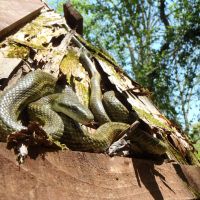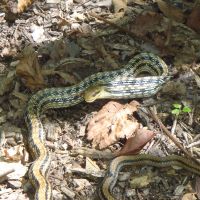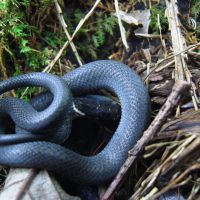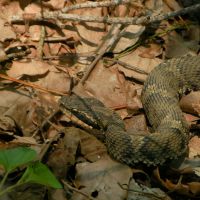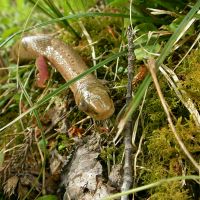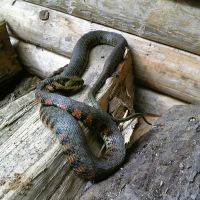Before long now, coming hot on the tail of a Year of the Dragon, it will be a Year of the Snake in the Chinese zodiac; a year that's supposed to be lucky. Obviously, though, you shouldn't push your luck with any snakes you happen to meet up with at any time — especially conniving human ones in the grass.
When I was a boy growing up in Britain, snakes fascinated me, although in the wild I only ever saw two kinds: the harmless grass snake and the venomous viper (or adder). There is another, very rare species in Britain called the smooth snake, but I never saw one. All three indigenous wild snakes there are strictly protected — which is not at all the treatment bestowed on serpents in Japan.
As far as I know, including sea snakes, there are 47 species of snakes in Japan — the most deadly of which is the Okinawan habu (pit viper).
If you wander around in the bushes at night in Okinawa, you'll very likely meet up with one of these, so I would strongly caution against venturing out on nocturnal nature hikes because habu snakes have heat-sensors in their snouts that tell them to strike out at any warm body in the dark.
If you really are keen to study these snakes, it's much easier to see what they look like by eyeing the ones that brewers leave to pickle in the bottom of some bottles of Okinawan awamori rice liquor. This yellowish reptilian cocktail is supposed to do all kinds of things to your libido if you drink it — I've tried it once, but all it did was make me rush to swill the taste away with another beer.
In our Afan Trust woods here in the Nagano Prefecture hills we have six kinds of snakes, the most venomous of which is the mamushi (Japanese viper). This is a small snake, rarely exceeding 80 cm in length, and it's perfectly harmless as long as you leave it alone.
However, our forester Mr. Matsuki, who retired last year, has twice been bitten by these vipers, each time in the hand. I know for sure that the first time he had grabbed at the snake with the intention of sticking it in a bottle and filling it up with shōchū liquor. He doesn't drink the stuff himself, but swears that viper-added liquor makes the best liniment ever.
The next time he got bitten was when, as he insists, he accidentally put his hand on a viper sunning itself on a rock by a stream. Mr. Matsuki (he says ...) bent down to drink from the stream and accidentally rested his hand on the snake.
Each time he was bitten, he employed the classic snakebite first-aid response of slicing the punctured area open and sucking out and spitting out the blood and venom before tightly binding up his hand and driving to our local hospital. The last time, he got shots of antibodies for the venom and afterward he was very ill. He insists that it was the doctor's jabs that sickened him, not the snakebite.
Mrs. Matsuki was very, very cross, so I don't think there will be any more attempts to make viper liniment in that household.
The other venomous snake we have in our woods is the yamakagashi (tiger keelback), and full-grown these usually average between 60 cm and 1 meter long. This rather beautiful animal has small, venomous back teeth intended for rodents and frogs, so if you don't go and stick your finger or anything else of that size down its throat, it won't be worrying you.
Our biggest snake, which is also the most common in this country, is the aodaisho (Japanese rat snake — or green general) which can reach 2 meters or more in length.
Last summer, my 5-year-old identical-twin granddaughters were here from Canada, together with their mother (my oldest daughter) and her husband. The girls, like their parents, are fascinated by all wildlife, big and small. One day when the girls went to the woods with their mother, they ran ahead and vanished behind a large oak tree. When their mother caught up with them they were holding a large snake, which had a noticeable bulge in its belly. (Which was probably why it was slow and sleepy enough for the girls to grab it.)
Their mother let out a shriek — not that she's scared of snakes, but she didn't like seeing her little ones in their blissful ignorance holding out a big live one. The shriek alarmed the twins so they dropped the snake, which — no doubt even more alarmed — made a slithery escape into the grass and bushes.
"Mummy, you scared it!" came the protest.
"It was a snake! It might have bitten you!"
The twins shook their heads and looked at each other. "It was a girl snake," they said, mistaking the bulge for pregnancy. "Girl snakes don't bite other girls."
My daughter asked me to talk to the twins, and I told them that there were some types of snakes in the woods with poisonous bites. But the twins wouldn't listen to granddad either, and just repeated that girl snakes never bite other girls. I also tried to tell them that the aodaisho gets pregnant with eggs, which don't show as a single big bulge, and that the bulge was probably caused by an ingested rat. No matter, the girls just shook their heads.
"Mr. Matsuki was bitten twice by snakes in these woods," said I.
"That's because he's a boy," came the reply.
I gave up, for this time anyway. Arguing with one little girl is bad enough, but have you ever tried arguing with two of them who look exactly the same? It's frustration in stereo!
Another kind of snake in our woods is the native shima hebi (Japanese four-lined rat snake, or Japanese striped snake), which can reach 1.5 meters in length and is very attractive with its yellow underjaw and four distinct lines down its body.
We also have 70 cm-to-1 meter jimuguri (forest rat snakes), which have a beautiful orange coloring with dark stripes; and the rather rarer hibakari (Japanese keelback), a small (up to 40 cm long) species that's pale orange in color.
We welcome the presence of snakes, because they help keep down the mice and voles that do a lot of damage in the winter when they chew on the roots of the trees we have planted. Also, because of the various ponds and waterways we have made, we have lots of frogs.
I honestly do believe that snakes are beautiful — but never even try to stroke or fondle the harmless ones, female or otherwise, let alone their venomous cousins.
And best wishes to all Notebook readers for a happy and fruitful Year of the Snake, which comes round on Feb. 10.



